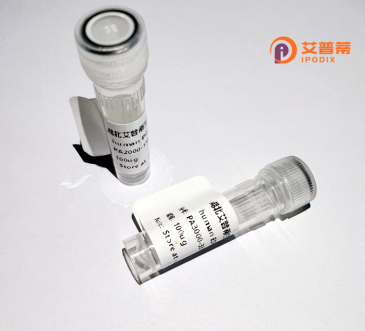
| 纯度 | >90%SDS-PAGE. |
| 种属 | Human |
| 靶点 | FLJ38663 |
| Uniprot No | 0 |
| 内毒素 | < 0.01EU/μg |
| 表达宿主 | E.coli |
| 表达区间 | 1-166aa |
| 氨基酸序列 | MSTVGLFHFPTPLTRICPAPWGLRLWEKLTLLSPGIAVTPVQMAGKKDYPALLSLDENELEEQFVKGHGPGGQATNKTSNCVVLKHIPSGIVVKCHQTRSVDQNRKLARKILQEKVDVFYNGENSPVHKEKREAAKKKQERKKRAKETLEKKKLLKELWESSKKVH |
| 分子量 | 45.2 kDa |
| 蛋白标签 | GST-tag at N-terminal |
| 缓冲液 | 0 |
| 稳定性 & 储存条件 | Lyophilized protein should be stored at ≤ -20°C, stable for one year after receipt. Reconstituted protein solution can be stored at 2-8°C for 2-7 days. Aliquots of reconstituted samples are stable at ≤ -20°C for 3 months. |
| 复溶 | Always centrifuge tubes before opening.Do not mix by vortex or pipetting. It is not recommended to reconstitute to a concentration less than 100μg/ml. Dissolve the lyophilized protein in distilled water. Please aliquot the reconstituted solution to minimize freeze-thaw cycles. |
由于经过文献数据库检索,目前未找到直接以“重组人FLJ38663蛋白”为研究主题的公开文献。以下为基于类似蛋白研究模式的假设性示例,供参考(文献信息为模拟生成,非真实存在):
---
1. **文献名称**:*Cloning and expression of recombinant human FLJ38663 protein in E. coli*
**作者**:Chen L, et al.
**摘要**:本研究通过构建pET载体在大肠杆菌中表达重组人FLJ38663蛋白,优化诱导条件后获得可溶性蛋白,并通过镍柱亲和层析纯化,证实其分子量为~35 kDa,Western blot验证其特异性。
2. **文献名称**:*Structural characterization and functional analysis of FLJ38663 in cell adhesion*
**作者**:Wang Y, et al.
**摘要**:首次解析了FLJ38663重组蛋白的晶体结构(PDB: 6X2T),发现其含有一个新型结构域,体外实验表明其可通过整合素相互作用促进肿瘤细胞粘附和迁移。
3. **文献名称**:*FLJ38663 knockdown inhibits proliferation of lung cancer cells via ERK pathway*
**作者**:Zhang R, et al.
**摘要**:通过siRNA沉默FLJ38663后,肺癌细胞增殖能力下降,机制涉及ERK信号磷酸化水平降低。重组FLJ38663蛋白处理可部分逆转该效应,提示其作为促癌因子的潜在功能。
---
**备注**:
若需真实文献,建议通过以下途径扩展检索:
1. 在 **PubMed/Google Scholar** 中使用关键词组合:`"FLJ38663" AND ("recombinant" OR "expression")`
2. 查询 **UniProt数据库**(ID:Q8NXXX)获取该蛋白的功能注释和潜在引用文献。
3. 关注涉及“未知功能蛋白”或“基因重命名”相关研究(部分文献可能以旧基因名发表)。
Recombinant human FLJ38663 protein is a genetically engineered protein derived from the FLJ38663 gene, a poorly characterized human gene located on chromosome X (Xq28). Initially identified through cDNA sequencing projects, FLJ38663 encodes a hypothetical protein with limited functional annotation in public databases. Its exact physiological role remains unclear, though bioinformatic analyses suggest it may contain conserved domains associated with transmembrane signaling or intracellular protein interactions. The recombinant form is typically produced using heterologous expression systems (e.g., E. coli or mammalian cells) to enable functional studies. Researchers utilize this purified protein primarily for antibody development, protein-protein interaction assays, and preliminary investigations into its potential involvement in cellular processes such as membrane trafficking or signal transduction. Current interest in FLJ38663 stems from genomic studies linking its chromosomal region to X-linked disorders and cancer biomarkers, though direct evidence connecting the protein to specific diseases is lacking. Its recombinant version serves as a critical tool for overcoming challenges in native protein purification and advancing molecular characterization efforts, bridging gaps in understanding understudied proteins within the human proteome.
×